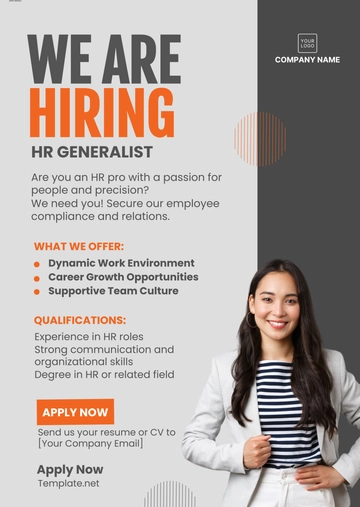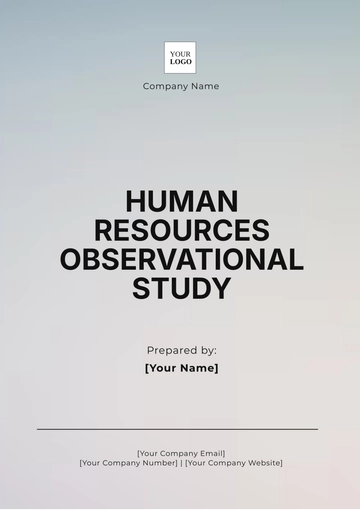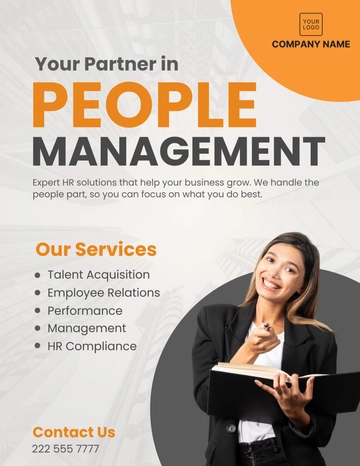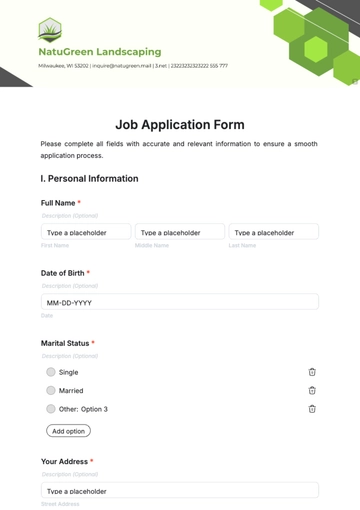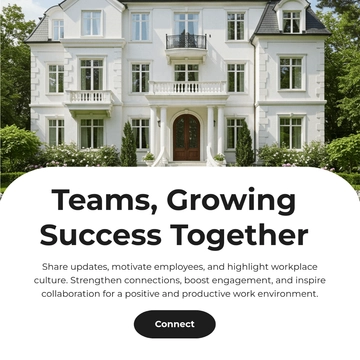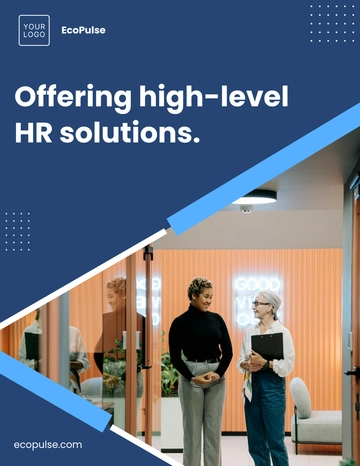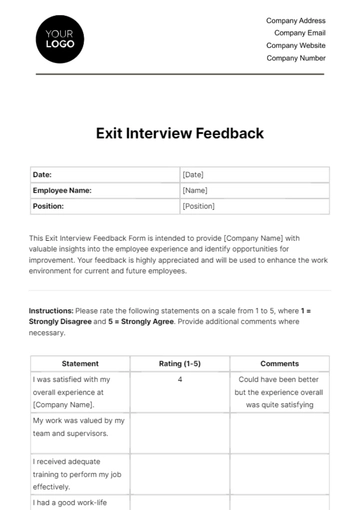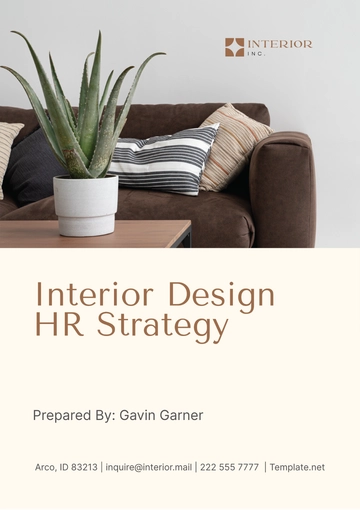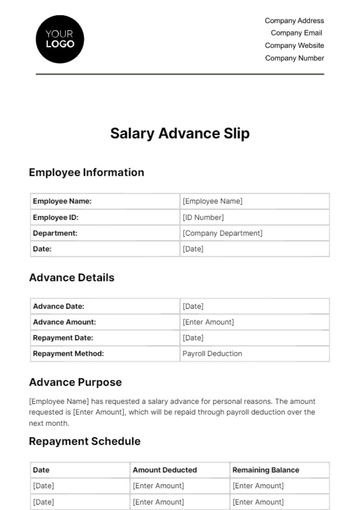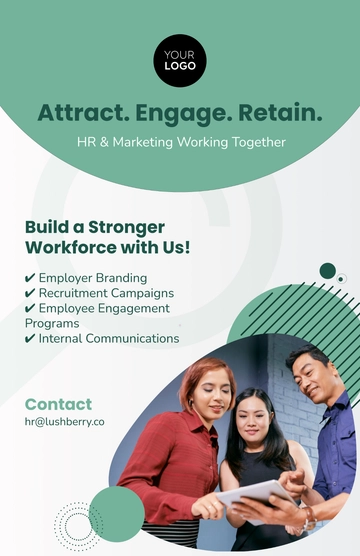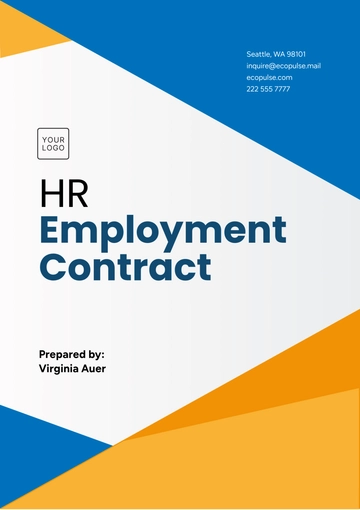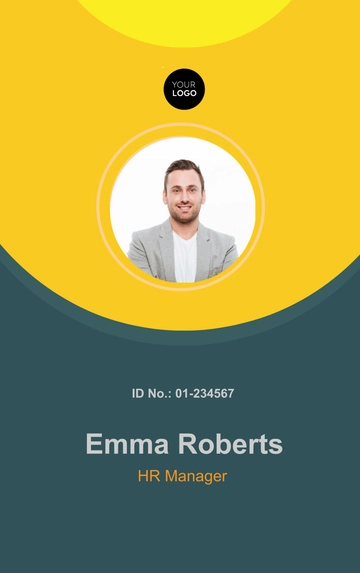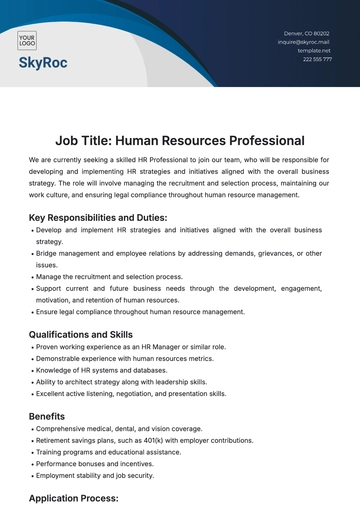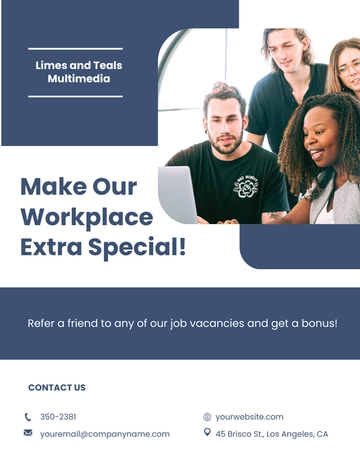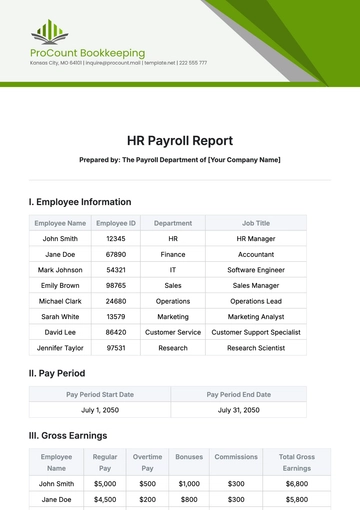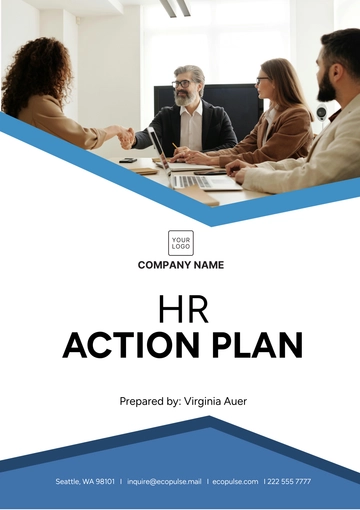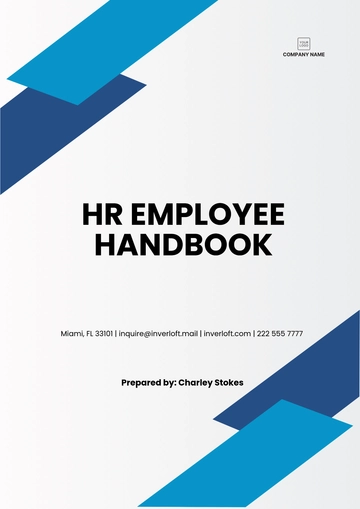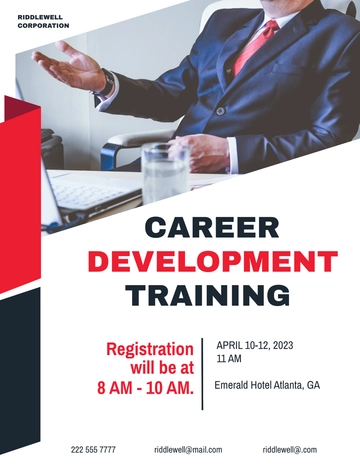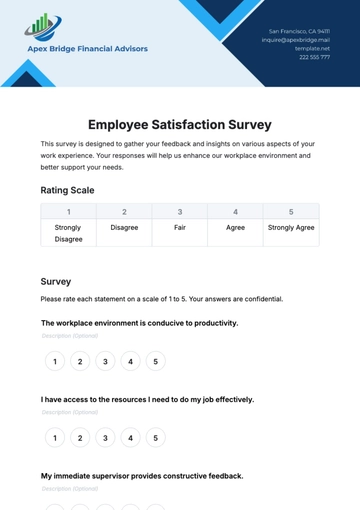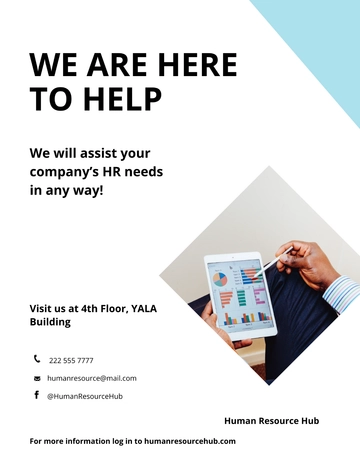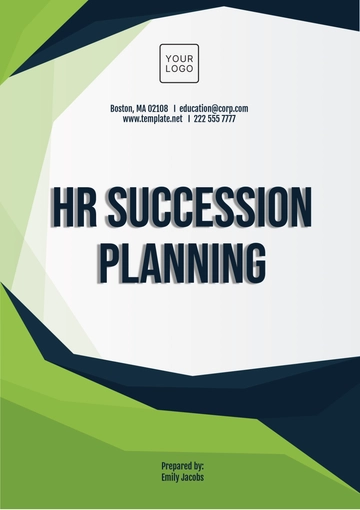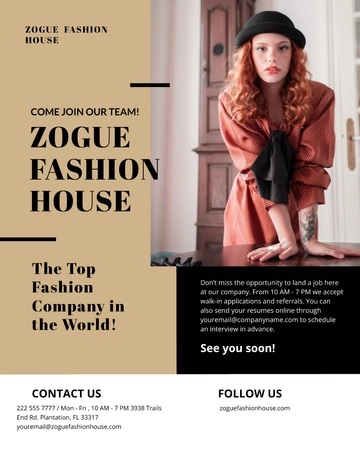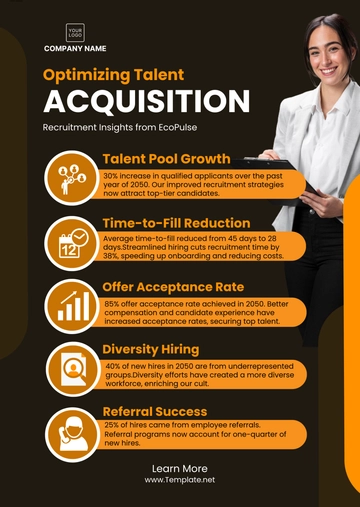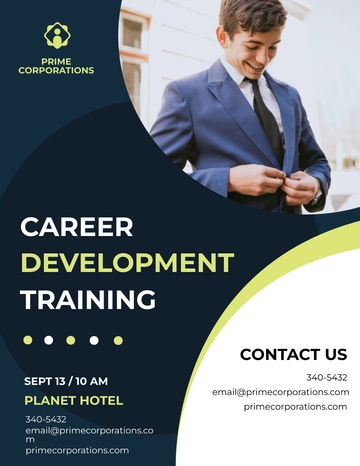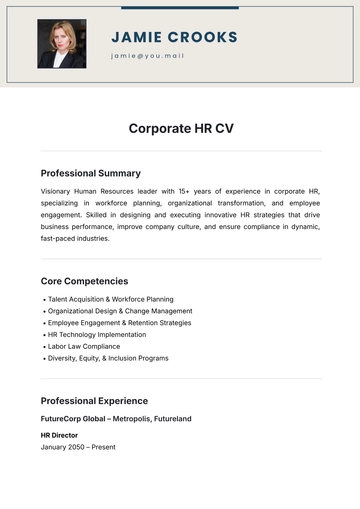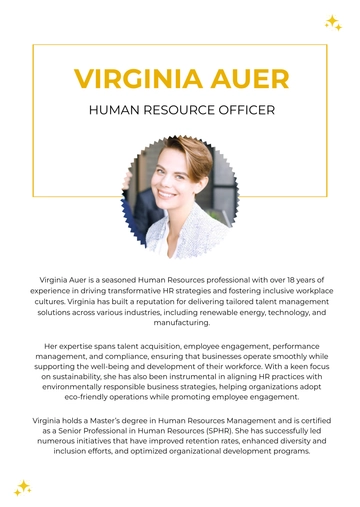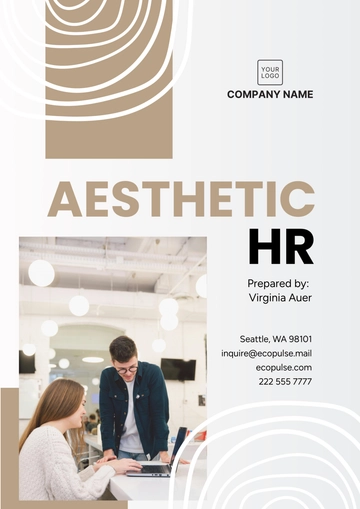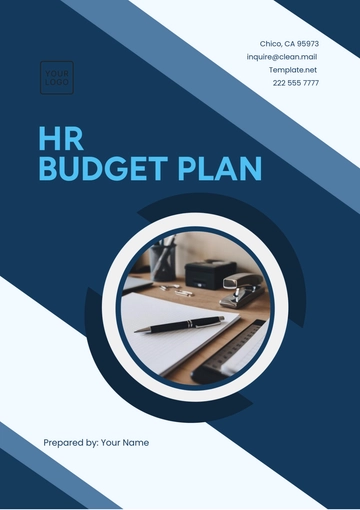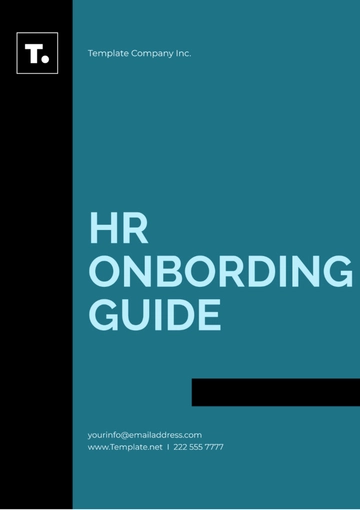Free Interior Design HR Strategy
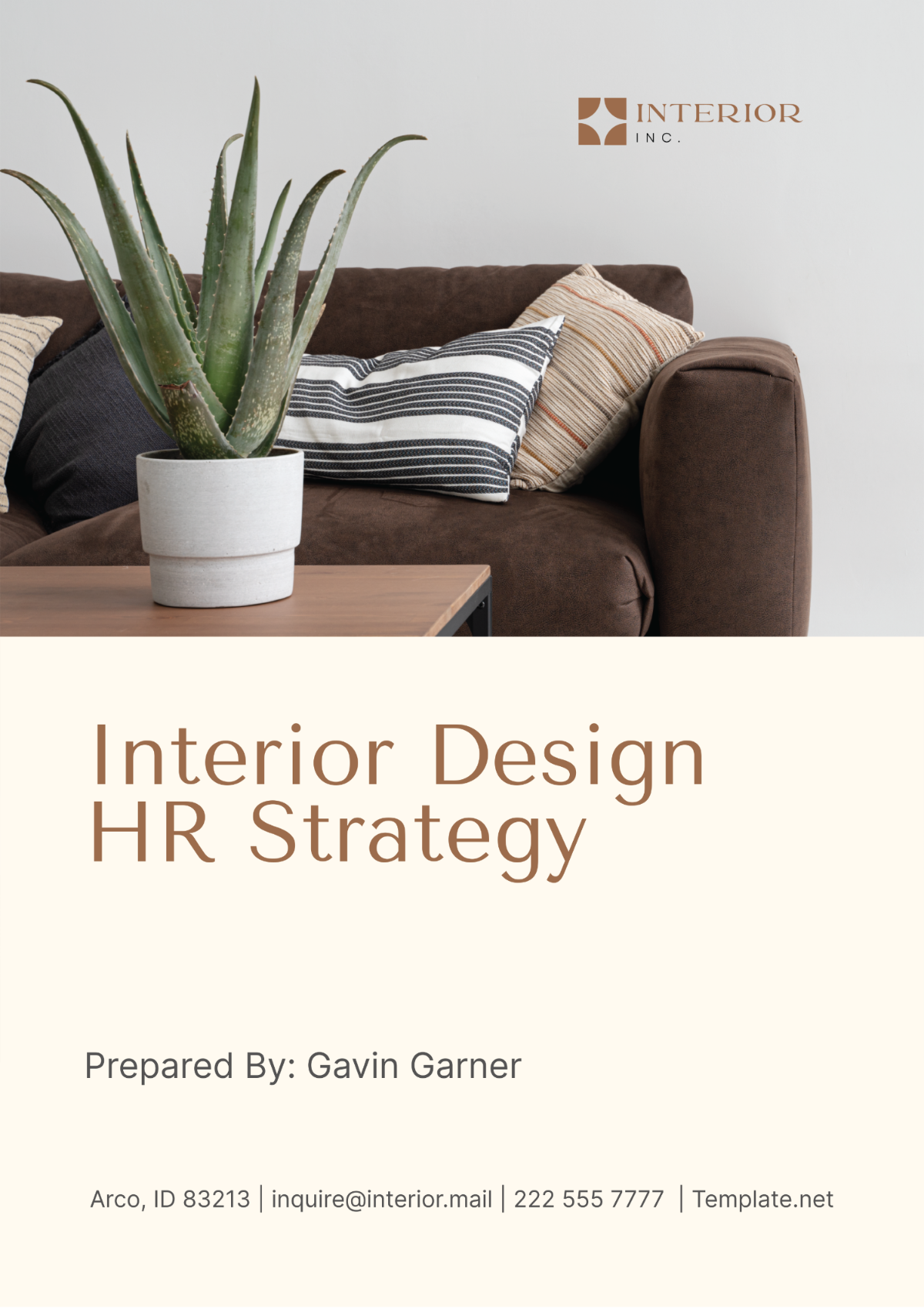
I. Purpose
The purpose of our HR strategy is to align the human resource management with our overall business objectives, fostering a workplace that champions creativity, efficiency, and continuous improvement. This strategy outlines our approach to harnessing the potential of our staff, ensuring that every team member is equipped, motivated, and aligned with our vision of delivering outstanding interior design services. It serves as a roadmap for cultivating a skilled, diverse, and innovative workforce capable of meeting the dynamic needs of our industry.
II. Recruitment and Hiring
A. Defining Job Roles and Responsibilities
Clearly defined job roles and responsibilities are crucial for attracting the right talent and ensuring effective performance. We maintain clarity and transparency in our job descriptions to ensure potential candidates understand what is expected of them. Below is a table illustrating typical roles within our firm and their core responsibilities:
Role | Responsibilities |
|---|---|
Interior Designer | Design conceptualization, client interaction |
Project Manager | Oversight of project timelines, budgeting, team coordination |
CAD Technician | Production of detailed drawings, support to designers |
Admin Assistant | Office management, scheduling, client correspondence |
B. Talent Acquisition Strategies
Our approach to talent acquisition is strategic and multi-faceted to ensure we attract skilled professionals who can contribute to our firm's success. We employ various strategies, including:
Leveraging industry-specific job portals to post vacancies.
Utilizing social media platforms and professional networks like LinkedIn.
Participating in job fairs and career events focused on creative industries.
Establishing internship programs to nurture early-career talent.
C. Best Practices for Recruiting Creative Talent
Recruiting creative talent requires a nuanced approach that goes beyond conventional hiring practices. Our best practices include:
Emphasizing a portfolio review as part of the hiring process.
Conducting structured interviews that include scenario-based questions.
Inviting candidates to participate in a "day in the life" experience.
Using behavioral assessment tools to better understand candidate personalities and how they might fit into our team dynamics.
D. Onboarding Process for New Hires
A structured onboarding process is essential to integrate new hires into our operations and culture effectively. Our onboarding steps include:
Introduction to team members and key departments.
Comprehensive overview of company policies, culture, and expectations.
Assignment of a mentor for guidance during the first few months.
Ongoing training sessions to fully equip new hires with the necessary tools and knowledge for their role.
III. Employee Development and Training
We are dedicated to fostering an environment where continuous learning and skill enhancement are not only encouraged but facilitated. Our employee development and training programs are designed to support career growth and ensure our team remains at the forefront of the interior design industry. The following table outlines our core training programs and their objectives:
Focus Area | Objective |
|---|---|
Advanced design skills | To enhance creative and technical design abilities |
Management skills | To develop leadership for managing teams and clients |
Technical skills | To ensure fluency in essential design software tools |
Communication skills | To improve client interaction and satisfaction |
To support continuous learning and adaptation, we commit to providing regular training sessions, workshops, and seminars that address both the current needs and emerging trends in the interior design field. We encourage our employees to participate in industry conferences and external workshops, for which we offer sponsorship opportunities. Additionally, we promote a culture of mentorship and peer learning, where more experienced employees guide and support newer team members, facilitating knowledge exchange and fostering a collaborative work environment.
IV. Performance Management
Our performance management system is structured to ensure that all employees are clear about their goals and expected contributions to the firm's success. We use a combination of quantitative and qualitative metrics to assess performance fairly and comprehensively. Below is a table outlining key performance indicators (KPIs), along with their target values:
KPI | Target Value |
|---|---|
Client Satisfaction | 90% satisfaction rate |
Project Delivery | On-time delivery 95% |
Budget Adherence | Within budget 90% |
Personal Development | Complete 2 trainings per year |
Employees who consistently exceed these targets are recognized and rewarded through our comprehensive incentive system, which includes bonuses, promotions, and additional professional development opportunities. Conversely, employees who fall short of these metrics are provided with constructive feedback and personalized performance improvement plans. These plans are designed to help them address specific areas of concern, with the support of additional training and mentorship, to enhance their capabilities and align their performance with organizational goals.
V. Work Culture and Environment
A. Fostering Creativity and Innovation
We recognize that creativity is the lifeblood of our business. To foster an environment that encourages creativity and innovation, we provide a workspace that is inspiring and vibrant, equipped with the resources that our designers need to think freely and innovate. Regular creative challenges and brainstorming sessions are held to encourage new ideas and approaches.
B. Building a Collaborative Team Environment
Collaboration is key in a multidisciplinary field like interior design. We promote a team environment where open communication, mutual respect, and cooperative problem-solving are the norms. Our open-plan office spaces and collaborative tools are designed to facilitate easy sharing of ideas and foster teamwork across projects.
C. Managing Work-Life Balance
We are committed to supporting our employees in achieving a healthy work-life balance. Flexible working hours, remote work options, and generous leave policies are part of our approach. We also provide recreational activities and team outings that help relieve stress and promote a sense of well-being among our team members.
D. Diversity and Inclusion Initiatives
Our firm values diversity and is committed to creating an inclusive environment where everyone, regardless of their background, can thrive. We actively seek to recruit a diverse workforce and have implemented policies that promote inclusion and equality, such as sensitivity training sessions and a zero-tolerance policy towards discrimination.
VI. Compensation and Benefits
We offer competitive compensation packages that reflect the skills, experience, and contributions of our employees. Our salary structure is designed to be transparent and equitable, rewarding both the creativity and the technical expertise that our team brings to their roles. Below is an indicative table of our salary structure:
Position | Entry-Level | Mid-Level | Senior-Level |
|---|---|---|---|
Interior Designer | $40,000 | $55,000 | $75,000+ |
Project Manager | $50,000 | $65,000 | $85,000+ |
CAD Technician | $35,000 | $45,000 | $60,000+ |
Administrative Assistant | $30,000 | $40,000 | $50,000+ |
Beyond basic salaries, we offer incentive programs designed to reward outstanding performance and drive engagement. These incentives include performance bonuses, profit-sharing plans, and stock options for senior roles. Additionally, employees achieving significant milestones or demonstrating exceptional leadership receive recognition awards and special bonuses, further aligning individual achievements with our company’s success.
VII. Employee Relations
A. Conflict Resolution Procedures
We acknowledge that conflicts may arise in any workplace and have established procedures to address and resolve them constructively. Our approach emphasizes open communication, impartiality, and swift resolution. Key steps in our conflict resolution process include:
Immediate Discussion
Mediation
Escalation
Resolution Plan
B. Grievance Handling Mechanisms
Our grievance handling mechanisms are designed to ensure that all employees feel heard and valued. We handle grievances with seriousness and discretion, ensuring confidentiality and fairness throughout the process. The key steps include:
Submission of Written Complaint
Investigation
Meeting
Resolution
C. Employee Assistance Programs (EAP)
Our Employee Assistance Programs (EAP) are structured to provide support and resources to employees facing personal or professional challenges. These programs include:
Counseling Services
Legal Assistance
Financial Advising
Wellness Programs
D. Legal Compliance and Ethical Standards
Adhering to legal compliance and maintaining high ethical standards are foundational to our operations. We ensure that our practices align with the following U.S. standards:
Equal Employment Opportunity (EEO)
Americans with Disabilities Act (ADA)
Fair Labor Standards Act (FLSA)
Occupational Safety and Health Administration (OSHA)
VIII. Workforce Planning and Management
A. Forecasting Staffing Needs Based on Project Pipelines
We actively monitor our project pipelines to anticipate staffing needs accurately, ensuring that we have the right number of skilled professionals for upcoming projects. This involves close collaboration between our project management and HR teams to analyze project scopes, durations, and specific skill requirements. We use historical data and current market trends to predict future demands, adjusting our recruitment and staffing strategies accordingly. This proactive approach helps us maintain workforce flexibility and efficiency, preventing both understaffing and overstaffing scenarios.
B. Succession Planning for Key Roles
Succession planning is a critical component of our workforce management strategy, ensuring leadership continuity and organizational resilience. We identify key roles within our organization and develop a pipeline of potential successors by evaluating current employees' performance, leadership potential, and career aspirations. Through targeted development programs, mentoring, and rotational assignments, we prepare these candidates to step into their future roles effectively, ensuring that our firm remains robust in its leadership structure over the long term.
C. Managing Freelancers and Contract Employees
Our flexible workforce model includes freelancers and contract employees who allow us to scale our capacity rapidly in response to project needs. Managing this segment of our workforce involves clear communication of project requirements, timelines, and quality expectations. We use standardized contracts to ensure compliance and protect both parties' interests. Regular assessments and feedback loops are integrated into the workflow to maintain high standards and integrate these workers seamlessly into our project teams.
D. Adjustments During Economic Fluctuations
Economic fluctuations can impact project volumes and, consequently, workforce requirements. We prepare for these changes through flexible workforce planning and financial reserves that allow us to manage downturns without drastic cuts. During periods of economic contraction, we focus on training and upskilling employees, optimizing our operations, and exploring new market opportunities. In times of growth, we scale up efficiently through a mix of hiring and engaging more contract employees. This balanced approach ensures stability and continuity of service to our clients regardless of economic conditions.
IX. Sustainability and Corporate Responsibility
As a forward-thinking interior design firm, we are committed to sustainability and corporate responsibility in all aspects of our operations. Our initiatives are designed not only to minimize environmental impact but also to contribute positively to our community and the economy. Key initiatives include:
Green Design Practices: Incorporating sustainable materials and energy-efficient designs to reduce the environmental footprint of our projects.
Community Engagement: Participating in local initiatives that promote design education and community beautification projects.
Ethical Sourcing: Ensuring that all our materials and products are sourced from suppliers who adhere to ethical standards regarding labor and environmental practices.
Waste Reduction: Implementing recycling programs and waste reduction strategies in our offices and on our project sites.
X. HR Metrics and Analytics
To measure the effectiveness of our HR strategies and ensure alignment with our business objectives, we employ specific HR metrics. Below is a table of key metrics and their target values:
Metric | Target Value |
|---|---|
Employee Turnover Rate | Less than 10% |
Employee Satisfaction | 85% satisfaction score |
Training Completion Rate | 100% completion of mandatory training |
Time to Fill Vacancies | Average 30 days |
If these metrics are not met, we will take a structured approach to address the discrepancies. This includes conducting detailed analyses to understand the underlying causes, revising our HR policies and practices as necessary, and implementing targeted interventions. Regular review sessions will be scheduled to monitor progress and make continuous adjustments to ensure that our HR objectives are achieved.
XI. Conclusion
We are deeply committed to maintaining a workplace that supports and values its employees, fostering an environment conducive to professional growth, creativity, and personal well-being. Our HR strategy is crafted with the goal of not only meeting the current needs of our team but also anticipating future challenges and opportunities. By investing in our people and prioritizing their development and satisfaction, we are building a resilient and dynamic firm that is well-equipped to lead in the ever-evolving world of interior design. We pledge to continuously review and improve our practices to ensure they meet the highest standards of excellence and effectiveness.
- 100% Customizable, free editor
- Access 1 Million+ Templates, photo’s & graphics
- Download or share as a template
- Click and replace photos, graphics, text, backgrounds
- Resize, crop, AI write & more
- Access advanced editor
Revolutionize your HR strategy with Template.net's Interior Design HR Strategy Template. This customizable and editable document provides a roadmap for attracting, developing, and retaining top talent in the interior design industry. Crafted meticulously, it's editable in our AI Editor tool, ensuring seamless customization. Elevate your HR practices and drive organizational success with Template.net.
